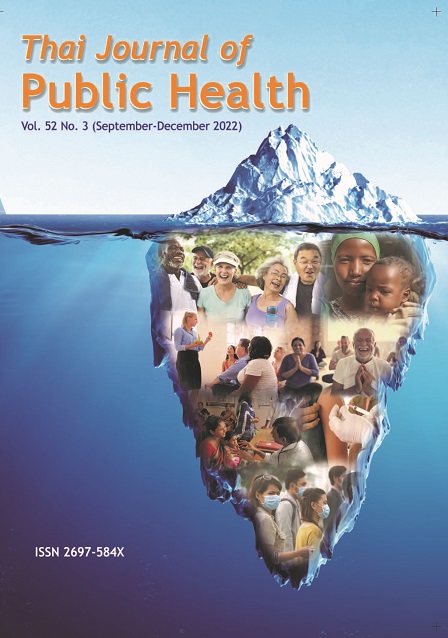Estimation of Reproduction Number of COVID-19 Spread Patterns in Thailand
Keywords:
Estimation, COVID-19, Exponential growth rate, Reproduction number, Emergency Decree and lockdown, ThailandAbstract
Coronavirus disease 2019 (COVID-19) caused by severe acute respiratory syndrome–coronavirus 2 (SARS-CoV-2) and was declared as a pandemic. The purpose of this study was to estimation the reproduction number of COVID-19 Spread Patterns by using the data from 22 January to 30 June 2020. We applied the exponential growth rate to estimate the basic reproduction number (R0) according to the status of lockdown. The exponential growth model results during lockdown period indicate the basic reproduction number is 0.58 (95% CI: 0.55-0.60), whereas the basic reproduction number is 0.98 during easing of lockdown. The highest value of the basic reproduction number is 2.48 (95% CI: 2.21-2.77) during pre-lockdown phase II. The reduction of basic reproduction numbers (R0). suggested that timely implementation of control measures. The estimation of reproduction numbers could be used to analyze and evaluate the effectiveness of control measures and also used as a guide for public health policymakers for future COVID-19 outbreak. Moreover, with COVID-19 cases still present in Thailand, an estimation of basic reproduction number (R0) would be helpful for continuous monitoring of the effectiveness of the current public health policies implemented in Thailand.
References
Abou-Ismail A. Compartmental models of the COVID-19 pandemic for physicians and physician-scientists. SN Compr Clin Med. 2020;2(7):852-8.
WHO O. Coronavirus Disease (COVID-19): Situation Report - 162 (30 June 2020). Available from: https://reliefweb.int/report/world/coronavirus-disease-covid-19-situation-report-162-30-june-2020, accessed 30 July, 2020.
WHO O. Novel Coronavirus – Thailand (ex-China). Available from: https://www.who.int/emergencies/disease-outbreak-news/item/2020-DON234, accessed 14 January, 2020.
Center for Systems Science and Engineering (CSSE) at Johns Hopkins University. COVID-19 Data Repository by the Center for Systems Science and Engineering (CSSE) at Johns Hopkins University. Available from: https://github.com/CSSEGISandData/COVID-19, accessed 5 July, 2020.
Newsroom TAoT. TAT update: Thailand invokes Emergency Decree from 26 March to 30 April, 2020 to combat COVID-19. Available from: https://www.tatnews.org/2020/03/tat-update-thailand-invokes-emergency-decree-from-26-march-to-30-april-2020-to-combat-covid-19/.
International Organization for Migration. COVID 19 Response - Flash Update: Migration Movement in the Greater Mekong Sub Region (GMS) - 26 March 2020. Available from: https://reliefweb.int/report/thailand/covid-19-response-flash-update-migration-movement-greater-mekong-sub-region-gms-26.
Thailand WHO. Coronavirus disease 2019 (COVID-19) WHO Thailand Situation Report – 22 March 2020. Available from: https://cdn.who.int/media/docs/default-source/searo/thailand/who-thailand-situation-report-29.pdf?sfvrsn=aba4d51e_0.
Newsroom TAoT. TAT update: Businesses and activities allowed to reopen with strict control from 3 May 2020. Available from: https://www.tatnews.org/2020/05/tat-update-businesses-and-activities-allowed-to-reopen-with-strict-control-from-3-may-2020/.
Thailand Convention and Exhibition Bureau. TCEB Situation Update COVID-19 Situation on 30 September 2022 Termination of Emergency Decree Lowering Status of COVID-19 to Communicable Disease Under Surveillance. Available from: https://www.businesseventsthailand.com/en/press-media/news-press-release/detail/1499-tceb-situation-update-covid-19-situation-on-30-september-2022-termination-of-emergency-decree-lowering-status-of-covid-19-to-communicable-disease-under-surveillance, accessed 9 December, 2022.
Musa SS, Zhao S, Wang MH, Habib AG, Mustapha UT, He D. Estimation of exponential growth rate and basic reproduction number of the coronavirus disease 2019 (COVID-19) in Africa. Infect Dis Poverty. 2020;9(1):1-6.
Yuan J, Li M, Lv G, Lu ZK. Monitoring transmissibility and mortality of COVID-19 in Europe.
Int J Infect Dis. 2020;95:311-5.
Tantrakarnapa K, Bhopdhornangkul B, Nakhaapakorn K. Influencing factors of COVID-19 spreading: a case study of Thailand. J Public Health. 2020:1-7.
Hfocus.org. Trends of COVID-19 in Thailand 2020 Available from: https://www.hfocus.org/content/2020/03/18753, accessed 9 December, 2022.
Rotejanaprasert C, Lawpoolsri S, Pan-Ngum W, Maude RJ. Preliminary estimation of temporal and spatiotemporal dynamic measures of COVID-19 transmission in Thailand. PloS one. 2020;15(9):e0239645.
Zhao S, Lin Q, Ran J, Musa SS, Yang G, Wang W, et al. Preliminary estimation of the basic reproduction number of novel coronavirus (2019-nCoV) in China, from 2019 to 2020: A data-driven analysis in the early phase of the outbreak. Int J Infect Dis. 2020;92:214-7.
Ben Hassen H, Elaoud A, Ben Salah N, Masmoudi A. A SIR-Poisson model for COVID-19: evolution and transmission inference in the Maghreb central regions. Arab J Sci Eng. 2021;46(1):93-102.
Alimohamadi Y, Taghdir M, Sepandi M. Estimate of the basic reproduction number for COVID-19: a systematic review and meta-analysis. J Prev Med Public Health. 2020;53(3):151.
Delamater PL, Street EJ, Leslie TF, Yang YT, Jacobsen KH. Complexity of the basic reproduction number (R0). Emerg Infect Dis. 2019;25(1):1.
Lipsitch M, Cohen T, Cooper B, Robins JM, Ma S, James L, et al. Transmission dynamics and control of severe acute respiratory syndrome. Science. 2003;300(5627):1966-70.
Rai B, Shukla A, Dwivedi LK. Estimates of serial interval for COVID-19: A systematic review and meta-analysis. Clin Epidemiol Glob Health. 2021;9:157-61.
Obadia T, Haneef R, Boëlle P-Y. The R0 package: a toolbox to estimate reproduction numbers for epidemic outbreaks. BMC Med Inform Decis Mak. 2012;12(1):1-9.
Griffin J, Casey M, Collins Á, Hunt K, McEvoy D, Byrne A, et al. Rapid review of available evidence on the serial interval and generation time of COVID-19. BMJ Open. 2020;10(11):e040263.
Bi Q, Wu Y, Mei S, Ye C, Zou X, Zhang Z, et al. Epidemiology and transmission of COVID-19 in 391 cases and 1286 of their close contacts in Shenzhen, China: a retrospective cohort study. Lancet Infect Dis. 2020;20(8):911-9.
Mokhayeri Y, Mohammadi R, Aghaali M, Nikbakht R, Taherpour N, Nakhaeizadeh M. Estimation of the basic reproduction number (R0) of the COVID-19 epidemic in Iran. Med J Islam Repub Iran. 2020.
Wallinga J, Lipsitch M. How generation intervals shape the relationship between growth rates and reproductive numbers. Proc Biol Sci. 2007;274(1609):599-604.
Boelle PY, Bernillon P, Desenclos JC. A preliminary estimation of the reproduction ratio for new influenza A (H1N1) from the outbreak in Mexico, March-April 2009. Euro Surveill. 2009;14(19):19205.
Hens N, Van Ranst M, Aerts M, Robesyn E, Van Damme P, Beutels P. Estimating the effective reproduction number for pandemic influenza from notification data made publicly available in real time: a multi-country analysis for influenza A/H1N1v 2009. Vaccine. 2011;29(5):896-904.
Tyagi R, Dwivedi LK, Sanzgiri A. Estimation of effective reproduction numbers for covid-19 using real-time bayesian method for india and its states. 2020.
Downloads
Published
Issue
Section
License

This work is licensed under a Creative Commons Attribution-NonCommercial-NoDerivatives 4.0 International License.
Creative Commons License CC-BY-ND


